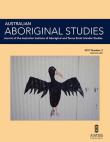 1987224763241949974.jpg
1987224763241949974.jpg
 1987224763241949974.jpg
1987224763241949974.jpg
'In May this year one group of leaders at the First Nations National Constitutional Convention made yet another heartfelt plea from Aboriginal and Torres Strait Islander people to be heard. Their statement is an attempt to influence public opinion about the nature of the problem by telling a broad audience that Aboriginal disadvantage does not have to be intractable. The Uluru statement may prove to be an influential voice in the public discourse about Aboriginal and Torres Strait Islander issues. We don’t know whether people will hear this time. We don't know whether the statement from Uluru has identified the right way to go.' (Editorial introduction)
Major Articles
Contents indexed selectively.
'Australian Indigenous studies: research and practice is an important and timely intervention into the scholarship currently informing the design and delivery of Indigenous studies in school curricula. Aimed primarily at school teachers and guided by the Australian Curriculum and Reporting Authority and the Australian Institute for School Teaching, the book offers a critical response to the ideological orthodoxies evident in both contemporary Indigenous studies curricula and approaches to teaching Indigenous students and their dependence on one-dimensional, culturally over-determined representations of ‘the Indigenous’ as they are promulgated by both Indigenous and non-Indigenous people. These representations and their continued reproduction — across various educational, governmental and other sites — typically construct indigeneity as radically different from and incommensurate with its non-Indigenous other, and it is this static binaristic notion of indigeneity that Australian Indigenous studies challenges. In making its alternative case for intercultural Indigenous studies, the book calls upon readers to complicate conventional understandings of indigeneity as a mode of identity construction and to recognise that it is simultaneously informed and made ambiguous by location-specific cultural, historical and other experiences, diverse intersubjective interactions and other intersecting layers of identity.' (Introduction)
'Early narratives of colonial exploration mythologised the role of the explorer. He, for inevitably the explorer was a man, was often cast as a lone heroic figure venturing into the vast uninhabited unknown. This mythical trope was a resilient one that found its way into published journals of exploration and works of literature and art well into the twentieth century. Yet the reality of colonial exploration was vastly different from the myth. The territory being explored was, in fact, inhabited and had been so for millennia. Furthermore, explorers relied on the expertise and knowledge of Indigenous intermediaries and mediators to navigate the unfamiliar landscape. It is the role of these intermediaries that is examined in Brokers and boundaries: colonial exploration in Indigenous territory. The editors of this volume of collected essays have brought together historians of Australia and Papua New Guinea to formulate new narratives in the history of exploration that address the complex interactions between explorers and intermediaries. These accounts draw attention to the agency that was often exercised by these intermediaries and the manner in which they used their positions to navigate relationships with not only colonial explorers but also other Indigenous peoples.' (Introduction)
'Jennifer Loureide Biddle’s Remote avant-garde: Aboriginal art under occupation champions the contemporary art practices of First Nations women artists working in Alice Springs and other remote communities of the Central and Western Deserts. The artists and art groups selected for inclusion speak to the diversity of current art production in one of Australia’s most active art scenes.' (Introduction)
'Gularabulu is an engaging collection of stories from the West Kimberley, told by Paddy Roe, a Nyigina man and prolific storyteller who lived in Broome, Western Australia, from 1912 to 2001. Roe was a fully initiated senior law man who played a central role in reviving and maintaining Aboriginal law and culture in the Broome area in the mid-twentieth century.' (Introduction)